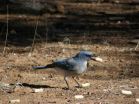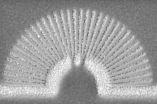(Press-News.org) This news release is available in French.
Certain blind individuals have the ability to use echoes from tongue or finger clicks to recognize objects in the distance, and some use echolocation as a replacement for vision. Research done by Dr. Mel Goodale, from the University of Western Ontario, in Canada, and colleagues around the world, is showing that echolocation in blind individuals is a full form of sensory substitution, and that blind echolocation experts recruit regions of the brain normally associated with visual perception when making echo-based assessments of objects. Dr. Goodale's latest results were presented at the 9th Annual Canadian Neuroscience Meeting, on May 24th 2015 in Vancouver British Columbia.
"Our experiments show that echolocation is not just a tool to help visually-impaired individuals navigate their environment, but can act as an effective sensory replacement for vision, allowing them to recognize the shape, size, and material properties of objects" says Mel Goodale.
Just like multiple properties (size, expected weight, texture, composition) of an object assessed by visual cues are encoded in different brain regions, recent research done in the Goodale laboratory shows that the same is true of information obtained through the auditory cues provided by echolocation. Indeed, many of the same regions in the sighted brain that are used for the visual assessment of objects are recruited in the blind brain when objects are explored using echolocation.
To understand what an object is, and to know how to interact with this object, knowing what an object is made of, its "stuff", is equally important as knowing its structure or shape. While his initial studies have investigated how echolocators detect the shape and distance of objects, Dr. Goodale's most recent studies have investigated how they perceive the material or "stuff" that different objects are made of.
"Remarkably, expert blind echolocators can tell whether something is hard or soft, dense or not, just by listening to the echoes bouncing back from that material" notes Dr. Goodale.
While sighted individuals use visual cues to get information about the composition of objects, such as the sheen of metal, or the fuzziness of fur, echolocators must rely on the auditory cues that result from the echoes of the clicks they emit. To determine how the brains of echolocators process these cues, researchers have recorded the echoes produced by echolocator's clicks on different materials (a blanket, fake foliage and a whiteboard) and looked at the response these sounds produced in the brains of sighted people, of blind non-echolocators and of blind echolocators. To view which brain regions were activated in these individuals, an advanced brain imaging technique called functional magnetic resonance imaging (fMRI) was used.
These studies show that material-related signals activate a region of the brain called the parahippocampal cortex (PHC) in blind expert echolocators, but not in sighted people or blind non-echolocators. PHC activation is associated with scene perception in sighted individuals. Just as in sighted individuals using vision, the brain regions that play a critical role in processing the structure and geometry of objects are distinct from the brain regions that process the cues that signal the material properties of objects in blind echolocators.
Interestingly, other studies in the Goodale lab have shown that blind expert echolocators are also subject to illusions, for example the size-weight illusion in which the perception of mass is influenced by the size of an object. If two objects of equal weight are presented to both a sighted and a blind echolocator, both will find the smaller object feels heavier when they lift it using a string attached to a pulley. This illusion, thought to be based on the lifter's cognitive expectations, and the fact that it is also present in blind echolocators, but not in blind non-echolocators, shows that echolocation is an effective form of sensory substitution for vision.
Because echolocation allows blind individuals to perceive objects from a distance, it can be used as an alternative to vision, allowing the perception of distant objects that would be impossible through touch. In fact, some echolocators are proficient enough to use this ability to perform complex tasks such as riding a bicycle - or even sinking a basketball!
INFORMATION:
Dr. Mel Goodale is Director of the Brain and Mind Institute at the University of Western Ontario. He holds the Canada Research Chair in Visual Neuroscience. Dr. Goodale is a member of the Royal Society of Canada and the Royal Society (London, UK).
Dr. Mel Goodale is the 2015 Presidential Lecturer at the 9th Annual Canadian Neuroscience Meeting. Learn more about Dr. Goodale here: Melvyn Goodale profile page: http://can-acn.org/melvyn-goodale-can2015-presidential-lecturer
About the Canadian Neuroscience Meeting
The Canadian Association for Neuroscience is holding its 9th Annual Meeting in Vancouver, May 24 to 27 2015. Held yearly since 2007, it brings together researchers working in all fields of neuroscience research. Organized by neuroscientists and for neuroscientists, it highlights the best and most novel neuroscience research in Canada every year.
About the Canadian Association for Neuroscience:
The Canadian Association for Neuroscience is the largest association dedicated to the promotion of all fields of neuroscience research in Canada. The association has been organizing a yearly annual meeting since 2007. Learn more about our meeting at:
http://can-acn.org/meeting2015
Seville, Spain - 24 May 2015: Cognitive impairment predicts worse outcome in elderly heart failure patients, reveals research presented today at Heart Failure 2015 by Hiroshi Saito, a physiotherapist at Kameda Medical Centre in Kamogawa, Japan. Patients with cognitive impairment had a 7.5 times greater risk of call cause death and heart failure readmission.
Heart failure patients with cognitive impairment may get progressively worse at adhering to medications, leading to poorer prognosis.
Heart Failure 2015 is the main annual meeting of the Heart Failure Association ...
SAN DIEGO - Results from a new nationwide survey announced today indicate a steady increase in the number of pediatric patients who are being treated with proton radiation therapy for cancerous and non-cancerous tumors.
The research, led by Andrew L. Chang, M.D., medical director of pediatrics with the Scripps Proton Therapy Center, was presented during the 54th annual Particle Therapy Co-Operative Group (PTCOG) Conference in San Diego, which runs through May 23.
Based on a survey of all proton therapy centers in the United States, the number of pediatric patients treated ...
Seville, Spain - 23 May 2015: Moderate to severe depression is associated with a 5-fold increased risk of all cause mortality in patients with heart failure, according to research presented today at Heart Failure 2015. The results from OPERA-HF show that risk was independent of comorbidities and severity of heart failure. Patients who were not depressed had an 80% lower mortality risk.
Heart Failure 2015 is the main annual meeting of the Heart Failure Association (HFA) of the European Society of Cardiology (ESC) and takes place 23 to 26 May in Seville, Spain. The scientific ...
Many animals feed on seeds, acorns or nuts. The common feature of these are that they have shells and there is no direct way to know what's inside. How do the animals know how much and what quality of food is hidden inside? A simple solution would be to break the shells, which often takes time and effort -- it would be a big disappointment to know that it's rotten or bad after the hard effort of opening the nuts!
Can animals evaluate the food hidden inside the nuts? This is especially important for some animals who cache the food items for later use without opening and ...
As a result of research performed by scientists at the University of Maryland School of Medicine (UM SOM), the U.S. Food and Drug Administration has approved the use of a drug to treat the deleterious effects of radiation exposure following a nuclear incident. The drug, Neupogen®, is the first ever approved for the treatment of acute radiation injury.
The research was done by Thomas J. MacVittie, PhD, professor, and Ann M. Farese, MA, MS, assistant professor, both in the University of Maryland School of Medicine (UM SOM) Department of Radiation Oncology's Division ...
MANHATTAN , Kansas -- A recent study with Kansas State University researchers details vaccine development for two new strains of avian influenza that can be transmitted from poultry to humans. The strains have led to the culling of millions of commercial chickens and turkeys as well as the death of hundreds of people.
The new vaccine development method is expected to help researchers make vaccines for emerging strains of avian influenza more quickly. This could reduce the number and intensity of large-scale outbreaks at poultry farms as well as curb human transmission.
It ...
New research by scientists at the University of Maryland School of Medicine has found that esophageal cancer patients treated with proton therapy experienced significantly less toxic side effects than patients treated with older radiation therapies.
Working with colleagues at the Mayo Clinic in Rochester, Minnesota and the MD Anderson Cancer Center in Dallas, Texas, Michael Chuong, MD, an assistant professor of radiation oncology at the school, compared two kinds of X-ray radiation with proton therapy, an innovative, precise approach that targets tumors while minimizing ...
May 22, 2015 - Boston, MA - Few professions in the world benefit from the sharing of information as much as meteorology. Nearly all countries around the world realize the value of sharing meteorological data across their borders. This information collaboration is vital to scientific understanding of the atmosphere and the oceans, as well as essential for accurate forecasts and timely warnings of hurricanes, typhoons, and other severe weather.
But what about when one country maintains an active embargo with another country?
That question was answered last year, when ...
BUFFALO, N.Y. -- It looks like a Slinky suspended in motion.
Yet this photonics advancement -- called a metamaterial hyperlens -- doesn't climb down stairs.
Instead, it improves our ability to see tiny objects.
Described in a research paper published today by the journal Nature Communications, the hyperlens may someday help detect some of the most lethal forms of cancer.
It could also lead to advancements in nanoelectronic manufacturing and boost scientists' ability to examine single molecules -- a development with implications in physics, chemistry, biology and other ...
WASHINGTON, D.C. -- Disaster investigators and emergency personnel may find themselves better able to assess and respond to terrorist attacks and industrial accidents with the aid of a new computational tool that determines the energy from explosions near the Earth's surface. As a first test of the new approach, its developers have analyzed a deadly explosion which reportedly killed dozens of regime soldiers in the Syrian civil war.
Computing the energy yield of an explosion just below, at, or above the ground poses difficult challenges, while deep-underground blasts ...

